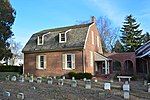Wyoming Historic District

Wyoming Historic District is a national historic district located at Wyoming, Kent County, Delaware. It encompasses 310 contributing buildings and 10 contributing structures in the town of Wyoming. It mainly consists of residential and commercial buildings developed after the arrival of the Delaware Railroad in 1855. Significant development occurred from the 1870s to 1941 and include examples of the Classical Revival, Bungalow/craftsman, and Queen Anne styles. Notable buildings include the town hall, the former W. M. Harris & Son Vinegar & Canning Factory, Wyoming mill complex, the Wyoming United Methodist Church, First National Bank of Wyoming, and the main building of the former Wyoming Institute. The Wyoming Railroad Station is located in the district and listed separately.It was listed on the National Register of Historic Places in 1987.
Excerpt from the Wikipedia article Wyoming Historic District (License: CC BY-SA 3.0, Authors, Images).Wyoming Historic District
North Railroad Avenue,
Geographical coordinates (GPS) Address Nearby Places Show on map
Geographical coordinates (GPS)
| Latitude | Longitude |
|---|---|
| N 39.119722222222 ° | E -75.558055555556 ° |
Address
North Railroad Avenue 201
19934
Delaware, United States
Open on Google Maps








